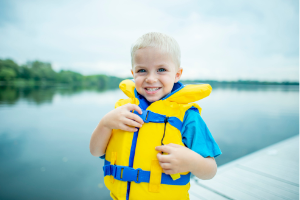
Summer water safety is incredibly important because drowning is the second leading cause of death in pediatrics. About 4,000 people drown each year in the USA with about 1,000 deaths in children less than 15 years of age. The male-to-female ratio is 3:1. According to the U.S. Consumer Product Safety Commission (CPSC) the swimming pool is the most common place for drowning, accounting for about 1/3 of all deaths. In adolescents, alcohol is involved in 50% of all drownings. The national rate is 1.5/per 100,000 people.
Drowning can occur in a pool, lake, ocean, river, stream, bucket, pail, ice chest with melted ice, bathtub, hot tub, spa, whirlpool, irrigation ditch, post hole, well, fountain, fish pond, toilet bowl, or thin ice over any body of water. If it contains water, it can be hazardous. Children have drowned in less than 3 inches of water.
The best way to prevent drowning is to follow some simple safety tips:
- Whenever young children are swimming, playing, or bathing in water, make sure an adult is constantly watching them. By definition, this means that the supervising adult should not read, play cards, talk on the phone, mow the lawn, or do any other distracting activity while watching children.
- Install a safety latch, doorknob cover, or lock on all bathroom doors. Keep toilet covers closed and locked shut.
- Avoid access to electric appliances in the bathroom.
- Never swim alone or in unsupervised places. Teach children to always swim with a buddy.
- Keep small children away from buckets containing liquid: 5-gallon industrial containers are a particular danger. Be sure to empty buckets when household chores are done.
- Never drink alcohol during or just before swimming, boating, or water skiing. Never drink alcohol while supervising children. Teach teenagers about the dangers of drinking alcohol and swimming, boating, or water skiing.
- To prevent choking, never chew gum or eat while swimming, diving, or playing in water.
- Learn to swim. Enroll yourself and/or your children aged 4 and older in swimming classes. Swimming classes are not recommended for children under age 4.
- Learn CPR (cardio-pulmonary resuscitation). This is particularly important for pool owners and individuals who regularly participate in water recreation.
- Do NOT use air-filled swimming aids (such as “water wings”) in place of life jackets or life preservers with children. These can give parents and children a false sense of security and increase the risk of drowning.
- Use one of the US Coast Guard approved life jackets or life preservers only. The life jacket should be worn at all times when on a boat or near a body of water. A child should learn how to use a life jacket as soon as possible. Make sure the jacket is the right size and the child is comfortable using it.
- Check the water depth before entering. The American Red Cross recommends 9 feet as a minimum depth for diving or jumping. Many people have broken their necks hitting the bottom of the pool, lake, stream, or pond.
- Caution your child about walking on thin ice during the winter.
If there is a swimming pool:
- Install a four-sided, isolation pool-fence with self-closing and self-latching gates around the pool. The fence should be at least 4 feet tall and should completely separate the pool from the house and play area of the yard.
- Prevent children from having direct access to a swimming pool.
- Install a telephone near the pool. Know how to contact local emergency medical services. Post the emergency number in an easy-to-see place.
- Learn CPR.
- Keep a life preserver and shepherd’s hook near the pool at all times.
- Keep electric appliances away from the pool.
- Do not allow wagons or bicycles near the pool.
- Never hold another person under water or call for help in fun.
For open waters:
- Know the local weather conditions and forecast before swimming or boating. Thunderstorms and strong winds can be extremely dangerous to swimmers and boaters.
- Restrict activities to designated swimming areas, which are usually marked by buoys.
- Be cautious, even with lifeguards present.
- Use U.S. Coast Guard-approved personal flotation devices (life jackets) when boating, regardless of distance to be traveled, size of boat, or swimming ability of boaters.
- Remember that open water usually has limited visibility, and conditions can sometimes change from hour to hour. Currents are often unpredictable — they can move rapidly and quickly change direction. A strong water current can carry even expert swimmers far from shore.
- Watch for dangerous waves and signs of rip currents — water that is discolored, unusually choppy, foamy, or filled with debris.
- If you are caught in a rip current, swim parallel to the shore. Once you are out of the current, swim toward the shore.
- Never swim during an electrical storm.
By following these rules the summer can be fun and safe for everyone.
Written by Dr. Michael Bornstein, who has over 28 years of experience as a pediatrician.
Disclaimer: The contents of this article, including text and images, are for informational purposes only and do not constitute a medical service. Always seek the advice of a physician or other qualified health professional for medical advice, diagnosis, and treatment.


FOLLOW US